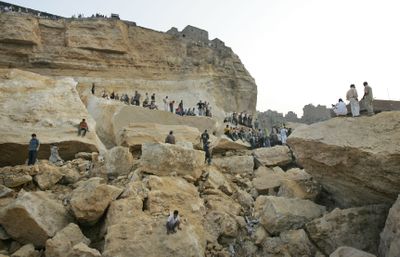Egypt rock slide devastates slum
Death toll 32; search goes on

CAIRO, Egypt – Hopes diminished Sunday for finding survivors among hundreds of people believed trapped beneath massive boulders that destroyed an impoverished neighborhood on Cairo’s outskirts, killing at least 32 people, including whole extended families.
Anger and resentment mounted as authorities failed for a second day to get heavy machinery into the devastated shantytown to try to clear the large slabs that split away from the Muqattam cliffs early Saturday. Survivors among the 100,000 residents of the Dewika slum were also left to spend the night without shelter, despite government promises to provide it.
“The area turned into a mass grave,” one bearded man shouted, while a tearful young woman in a black robe clutched a picture of a newlywed couple whose bodies remained trapped below.
Hundreds of anti-riot police in helmets and shields cordoned off the area to prevent journalists and residents from approaching the site. Only young residents who have been involved in the rescue efforts were allowed to get close.
“In America, rescue workers would hurry to save a cat. Here, hundreds of human beings are buried under the rocks and nobody seems to care,” said a taxi driver who was helping with the rescue but refused to give his name.
Many residents refused to give their names, saying they felt intimidated and threatened by the security forces in the area.
Rabie Ragab, whose house overlooks the boulders, accused the government of trying to deceive the public. “The minister of housing told the media that no one would sleep in the street. You can see that we all slept in the streets.”
State television reported that another body was pulled from the rubble Sunday, bringing the death toll to 32. A security official said 46 people were treated at hospitals, but that many other people remained buried. He spoke on condition of anonymity because he was not authorized to speak to the press.
The densely populated shantytown, part of a sprawling slum known as Manshiyet Nasr, is sandwiched between unstable cliffs and an unused railroad track that has made it difficult to get heavy recovery machinery into the area. More than 24 hours after the incident, rescue operations were still being carried out largely by hand and by residents.
Army personnel and Civil Defense workers managed to cut into the railway track and demolish several houses to clear the way for bulldozers.
Aboul-Ela Amin Mohammed, the head of the earthquake department at the National Research Institute for Astronomy and Geophysics, said the entire plateau is in danger of further collapse.
“It is not the first time or the last time,” he said. “The area is full of densely packed informal housing with no central sewer system. … When the sewage touches the fragile surface of the limestone it changes its consistency into a flour-like paste.”